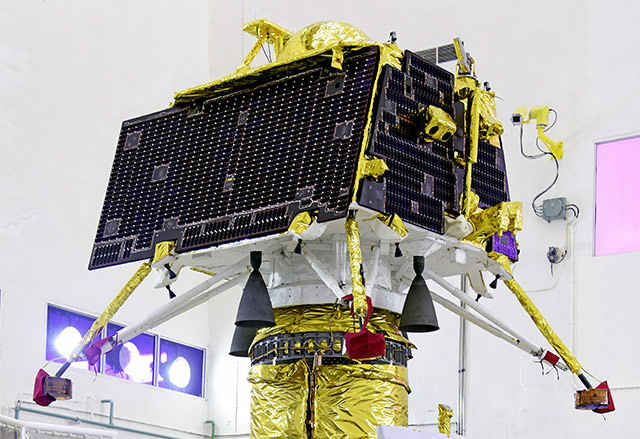ISRO loses communication link with Vikram lander during final stages of descent
Communications was lost with the Vikram lander in the last few nail biting minutes of the controlled descent. ISRO had successfully executed most of the soft landing near the south pole of the Moon with the Vikram lander, as part of the Chandrayaan 2 mission, but the spacecraft appeared to veer off course just towards the end. A period of confusion followed, where ISRO personnel indicated that they were not recieving any communications from the spacecraft. Officially, ISRO Chairperson K Sivan said, “Vikram lander descent was as planned, and normal performance was observed up to an altitude of 2.1 kilometer. Subsequently, the communications from the lander to ground station was lost. The data is being analysed.” There are also some indications from the trajectory that there was an attitude correction manoeuvre. The landing was the trickiest part of the mission, and the most technically sophisticated operation undertaken by ISRO in its history. One of the primary objectives of the mission was to demonstrate the capability of being able to execute a soft landing. Those of you who have been watching the live stream know that even at this late hour, the country was awake and preparing for a celebration. Prime Minister Narendra Modi was at the ISRO control center in Bengaluru, along with 60 school students from across the country who participated in the 'Space Quiz' contest to get a chance to be a part of this historic moment.
Fifteen Terrifying MinutesThe site of the landing was a high plane between the Simpelius N and Manzinus C craters, at a latitude of 70.9° South and a longitude of 22.7° East. An alternative landing site was 67.7 ° South 18.4° West, and perhaps things could have played out differently if this site were chosen. Vikram had a touchdown velocity of 2 meters per second. Considering the velocity, there was a chance that the lander could have crashed into the Moon, topple over or be unable to communicate, if things did not go exactly as planned. The landing site also had to be carefully chosen to eliminate any chance of Vikram ending up in an area of communications shadow, because of the local terrain. Ahead of the launch, K Sivan described the tricky operation, “these fifteen minutes are going to be the most terrifying for all the people who belong to ISRO, probably for the scientists and the people in India also. This is going to be the most difficult task ever undertaken by ISRO in a mission”. During the entire fifteen minutes, the thrusters had to be perpendicular to the surface of the Moon. The ISRO scientists also had to compare the images from the lander to previous images to make sure that the exact landing site did not have an inclination of more than 12 degrees. If the inclination was more, then Vikram would have toppled after the landing. The lander went through thorough drop testing at a specially designed test facility in Chitradurga, that simulated the terrain of the moon.

The Vikram Lander. Image: ISRO
The descent operations started from an altitude of 30 kilometers. The entire landing sequence was autonomous, without any command and control from the ground stations. The algorithms that were necessary to execute the soft landing were entirely developed by ISRO. The final trajectories for the lander were loaded four hours before the descent operation commenced. There were four phases to the descent, the rough braking phase, the attitude and absolute navigation control phase, the fine braking phase, and the terminal descent phase. The first phase brought down the lander from an altitude of 30 kilometers to 7.4 kilometers, the second phase brought down Vikram to 5 kilometers, the third to 400 meters, and the final phase gradually executes the touchdown, where the lander only moves vertically. 800 N of thrust were generated by the four engines on board. The steerable engines performed admirably during the controlled descent. Unfortunately, in the third phase of the landing, communication was lost with the Vikram lander. There is still hope though, it may be possible to reestablish communications. We do not yet know if the lander is just experiencing a communications problem, or something else has gone wrong. The data will have to be analysed to check if the algorithm was responsible for the lander veering off course, or there was some other reason. The four extendable legs on the lander were intended to dampen the impact and protect the sensitive instruments on board, as well as the Pragyaan rover. At this point of time, it is unknown if the landing was successfully executed. More details are awaited. As the PM noted though, it was no mean feat by ISRO scientists even to get as far as they did.
India is proud of our scientists! They’ve given their best and have always made India proud. These are moments to be courageous, and courageous we will be! Chairman @isro gave updates on Chandrayaan-2. We remain hopeful and will continue working hard on our space programme.
— Narendra Modi (@narendramodi) September 6, 2019
from Latest Technology News https://ift.tt/2zVG3CU

No comments